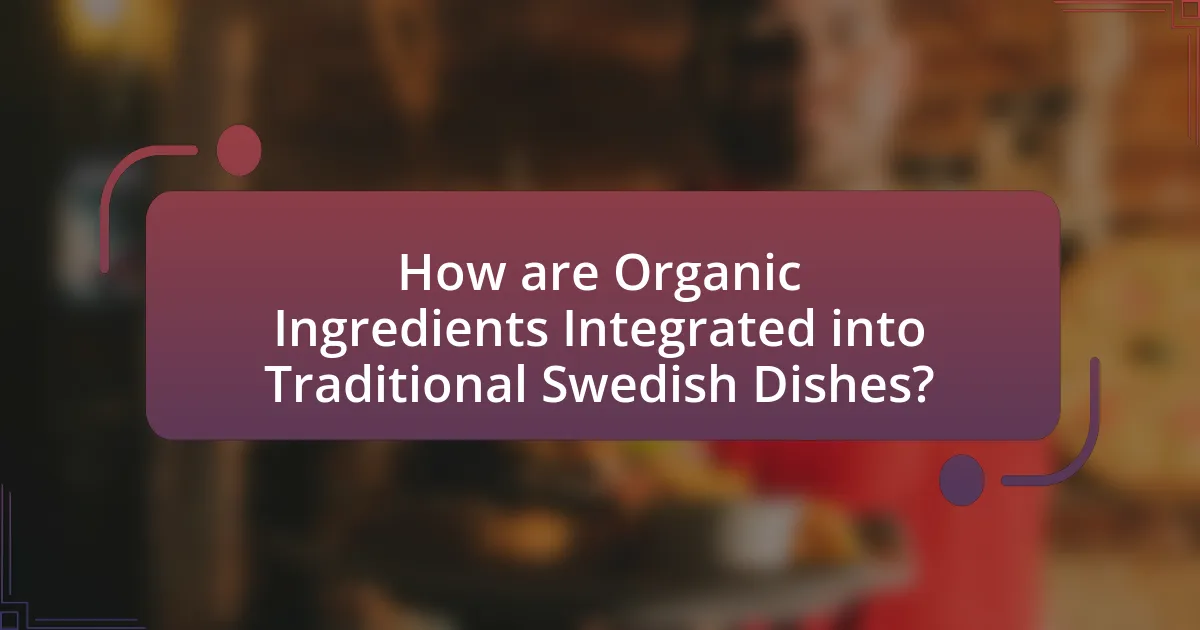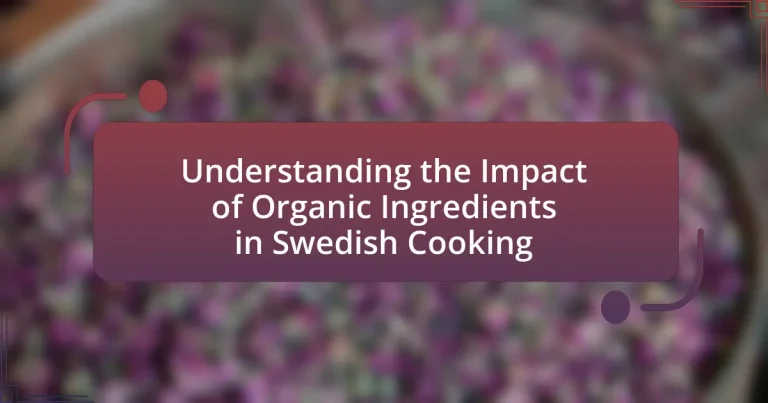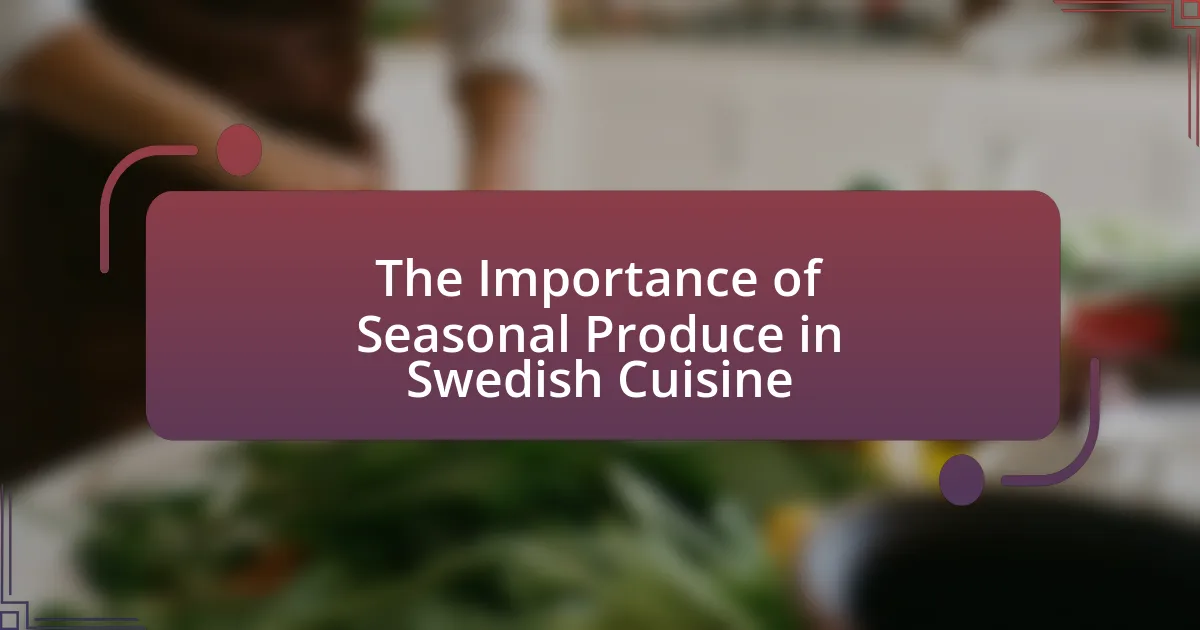The article focuses on the significance of organic ingredients in Swedish cooking, highlighting their role in promoting sustainability, enhancing food quality, and aligning with Sweden’s environmental values. It explains the differences between organic and conventional ingredients, the standards governing organic production, and the health benefits associated with organic foods. Additionally, the article addresses the challenges of sourcing organic ingredients, including cost and availability, while providing insights into how chefs incorporate these ingredients into traditional Swedish dishes. Overall, it emphasizes the importance of organic practices in creating a sustainable and health-conscious culinary landscape in Sweden.

What are Organic Ingredients in Swedish Cooking?
Organic ingredients in Swedish cooking refer to food products that are grown and processed without synthetic fertilizers, pesticides, or genetically modified organisms. These ingredients include vegetables like potatoes, carrots, and root vegetables, as well as grains such as barley and oats, which are staples in traditional Swedish dishes. The use of organic dairy products, such as milk and cheese, is also prevalent, as well as organic meats from animals raised in humane conditions. The emphasis on organic ingredients aligns with Sweden’s commitment to sustainability and environmental health, as evidenced by the country’s strong organic farming sector, which accounted for approximately 20% of total agricultural land in 2020.
How do organic ingredients differ from conventional ones?
Organic ingredients differ from conventional ones primarily in their production methods, which prohibit the use of synthetic pesticides, fertilizers, and genetically modified organisms (GMOs). Organic farming practices emphasize natural processes and biodiversity, often resulting in higher soil quality and environmental sustainability. For instance, according to the USDA, organic farming can enhance soil health and reduce pollution, as it relies on crop rotation and composting instead of chemical inputs. This distinction in agricultural practices leads to organic ingredients often being perceived as healthier and more environmentally friendly compared to their conventional counterparts.
What standards define organic ingredients in Sweden?
The standards that define organic ingredients in Sweden are primarily governed by the European Union’s organic farming regulations, specifically Regulation (EU) 2018/848. This regulation outlines the requirements for organic production, labeling, and control measures for organic products. In Sweden, the Swedish Board of Agriculture oversees the implementation of these standards, ensuring that organic ingredients are produced without synthetic pesticides, fertilizers, or genetically modified organisms. Additionally, organic certification bodies in Sweden, such as KRAV, provide further guidelines and certification processes that align with EU regulations, reinforcing the integrity of organic labeling and practices.
How is the sourcing of organic ingredients regulated?
The sourcing of organic ingredients is regulated primarily through national and international standards that ensure compliance with organic farming practices. In the European Union, Regulation (EU) 2018/848 outlines the requirements for organic production, including the prohibition of synthetic pesticides and fertilizers, and mandates that organic ingredients must be sourced from certified organic farms. Additionally, the USDA Organic certification in the United States provides a framework for organic labeling, requiring that products contain at least 95% organic ingredients. These regulations are enforced through inspections and audits by accredited certifying bodies, ensuring that producers adhere to the established organic standards.
Why is the use of organic ingredients important in Swedish cuisine?
The use of organic ingredients is important in Swedish cuisine because it promotes sustainability and enhances food quality. Organic farming practices reduce chemical pesticide and fertilizer use, which benefits the environment and public health. In Sweden, where there is a strong emphasis on ecological balance and local sourcing, organic ingredients align with cultural values of purity and natural flavors. Additionally, studies indicate that organic produce often contains higher levels of antioxidants and nutrients, contributing to better health outcomes. This commitment to organic ingredients reflects Sweden’s broader goals of environmental stewardship and high culinary standards.
What health benefits are associated with organic ingredients?
Organic ingredients offer several health benefits, including reduced exposure to pesticides and higher nutrient levels. Studies indicate that organic produce often contains higher concentrations of antioxidants, which are beneficial for reducing oxidative stress in the body. For instance, research published in the British Journal of Nutrition found that organic crops have significantly higher levels of phenolic compounds, which are linked to improved health outcomes. Additionally, organic farming practices promote biodiversity and soil health, contributing to a more sustainable food system that can enhance overall well-being.
How do organic ingredients impact flavor and quality in cooking?
Organic ingredients enhance flavor and quality in cooking by providing fresher, more vibrant tastes and higher nutritional value. Studies indicate that organic produce often contains higher levels of antioxidants and essential nutrients, which contribute to a richer flavor profile. For instance, research published in the Journal of Agricultural and Food Chemistry found that organic tomatoes had significantly higher levels of phenolic compounds, which are linked to improved taste and health benefits. Additionally, organic farming practices avoid synthetic pesticides and fertilizers, resulting in ingredients that are not only better for health but also contribute to a more authentic and robust culinary experience.
What role do organic ingredients play in sustainability?
Organic ingredients significantly contribute to sustainability by promoting environmentally friendly agricultural practices. These practices include crop rotation, reduced pesticide use, and enhanced soil health, which collectively lead to lower carbon emissions and improved biodiversity. According to the Food and Agriculture Organization, organic farming can reduce greenhouse gas emissions by up to 40% compared to conventional methods. Additionally, organic farming supports local economies by encouraging the consumption of locally sourced products, thereby reducing transportation emissions. This holistic approach not only benefits the environment but also fosters a sustainable food system that aligns with the principles of Swedish cooking, which emphasizes local and organic ingredients.
How do organic farming practices affect the environment?
Organic farming practices positively affect the environment by promoting biodiversity, improving soil health, and reducing pollution. These practices, which include crop rotation, composting, and the use of natural pest control methods, enhance the ecosystem by supporting a variety of plant and animal species. Research indicates that organic farming can increase soil organic matter by 20-30% compared to conventional methods, leading to better water retention and reduced erosion. Additionally, organic farming minimizes chemical runoff into waterways, which is a significant contributor to water pollution. According to a study published in the journal “Nature,” organic farming systems can reduce greenhouse gas emissions by up to 40% compared to conventional agriculture, further demonstrating their environmental benefits.
What is the economic impact of choosing organic ingredients?
Choosing organic ingredients generally leads to higher production costs, which can result in increased prices for consumers. Organic farming often requires more labor and stricter regulations, contributing to these elevated costs. For instance, a study by the USDA found that organic produce can be 20-100% more expensive than conventional options due to these factors. Additionally, the economic impact extends to local economies, as organic farming can create jobs and promote sustainable practices, potentially leading to long-term economic benefits.

How are Organic Ingredients Integrated into Traditional Swedish Dishes?
Organic ingredients are integrated into traditional Swedish dishes by sourcing locally grown produce, meats, and dairy that adhere to organic farming standards. This integration enhances the flavor and nutritional value of dishes such as herring, meatballs, and gravlax, while also supporting sustainable agricultural practices. For instance, the use of organic potatoes in the classic dish Janssons frestelse not only improves taste but also reduces chemical pesticide exposure. Additionally, many Swedish chefs emphasize the importance of organic ingredients in their cooking, reflecting a growing trend towards health-conscious and environmentally friendly food choices in Sweden.
What traditional Swedish dishes benefit from organic ingredients?
Traditional Swedish dishes that benefit from organic ingredients include gravlax, köttbullar (meatballs), and Janssons frestelse (Jansson’s temptation). Gravlax, made from salmon, is enhanced by organic herbs and spices, which contribute to its flavor and health benefits. Köttbullar, typically made from ground meat, gains improved taste and nutritional value when using organic beef or pork. Janssons frestelse, a creamy potato and anchovy casserole, benefits from organic potatoes and cream, ensuring a fresher and more authentic taste. The use of organic ingredients in these dishes aligns with Sweden’s emphasis on sustainability and quality in food production.
How can organic ingredients enhance classic recipes?
Organic ingredients can enhance classic recipes by improving flavor, nutritional value, and sustainability. The use of organic produce often results in richer, more vibrant flavors due to the absence of synthetic pesticides and fertilizers, which can alter taste profiles. Additionally, organic ingredients typically contain higher levels of vitamins and minerals, contributing to a more nutritious meal. For instance, a study published in the British Journal of Nutrition found that organic crops have significantly higher antioxidant content compared to conventionally grown crops. Furthermore, sourcing organic ingredients supports sustainable farming practices, which can lead to better environmental health and biodiversity. This holistic improvement in flavor, nutrition, and sustainability makes organic ingredients a valuable addition to classic recipes.
What are some examples of organic adaptations of traditional dishes?
Examples of organic adaptations of traditional dishes include organic meatballs, where grass-fed beef or organic pork replaces conventional meat, and organic gravlax, made with sustainably sourced salmon and organic sugar. These adaptations reflect a growing trend in Swedish cooking to prioritize organic ingredients, enhancing both flavor and sustainability. Research indicates that organic farming practices can improve soil health and reduce chemical runoff, supporting the shift towards organic adaptations in traditional recipes.
How do chefs in Sweden incorporate organic ingredients into their menus?
Chefs in Sweden incorporate organic ingredients into their menus by sourcing locally produced, seasonal, and certified organic products. This practice aligns with Sweden’s strong emphasis on sustainability and environmental responsibility, as evidenced by the fact that over 20% of the food consumed in Sweden is organic, according to the Swedish Board of Agriculture. Chefs often collaborate with local farmers and suppliers to ensure freshness and quality, which enhances the flavor and nutritional value of their dishes. Additionally, many Swedish restaurants highlight organic ingredients in their menus, showcasing them as a key component of their culinary identity.
What techniques do chefs use to highlight organic flavors?
Chefs use techniques such as minimal cooking, seasoning with natural herbs, and employing fermentation to highlight organic flavors. Minimal cooking preserves the integrity and freshness of organic ingredients, allowing their natural flavors to shine. Seasoning with herbs like dill or chives enhances the taste without overpowering it, maintaining the essence of the organic produce. Fermentation, a traditional method in Swedish cooking, adds depth and complexity to flavors while promoting the use of organic ingredients. These methods are rooted in the philosophy of respecting the quality of organic produce, which is often more flavorful and nutrient-dense than conventional options.
How do chefs source organic ingredients locally?
Chefs source organic ingredients locally by establishing direct relationships with local farmers and producers. This practice allows chefs to obtain fresh, seasonal produce while supporting sustainable agriculture. Many chefs participate in farmers’ markets or join community-supported agriculture (CSA) programs, which provide regular access to organic goods. Additionally, chefs often collaborate with local farms to create menus that reflect the availability of ingredients, ensuring that their dishes are both fresh and environmentally responsible. This approach not only enhances the quality of the food served but also fosters a connection between the culinary community and local agricultural practices.

What Challenges are Associated with Using Organic Ingredients in Swedish Cooking?
Using organic ingredients in Swedish cooking presents several challenges, including higher costs, limited availability, and shorter shelf life. The higher costs stem from the more labor-intensive farming practices associated with organic agriculture, which can make organic products significantly more expensive than conventional ones. Limited availability is often due to the smaller scale of organic farms, which may not be able to meet the demand for certain ingredients, especially in remote areas of Sweden. Additionally, organic ingredients typically have a shorter shelf life because they lack preservatives, leading to increased food waste if not consumed quickly. These factors can complicate meal planning and budgeting for consumers and chefs alike.
What are the common barriers to sourcing organic ingredients?
The common barriers to sourcing organic ingredients include limited availability, higher costs, and inconsistent supply chains. Limited availability arises from the fact that organic farming is less widespread compared to conventional farming, leading to fewer sources for organic produce. Higher costs are often associated with organic farming practices, which can result in higher prices for consumers and businesses. Inconsistent supply chains can disrupt access to organic ingredients, as fluctuations in production due to weather or market demand can lead to shortages. These factors collectively hinder the ability to consistently source organic ingredients for cooking.
How do seasonal availability and cost affect organic ingredient use?
Seasonal availability and cost significantly influence the use of organic ingredients in Swedish cooking. When organic ingredients are in season, they are typically more abundant and less expensive, encouraging chefs and home cooks to incorporate them into their dishes. For instance, during the summer months, local organic vegetables and fruits are plentiful, leading to increased usage in recipes. Conversely, when these ingredients are out of season, they become scarce and more costly, which can deter their use due to budget constraints. According to a study by the Swedish Board of Agriculture, the price of organic produce can be up to 30% higher during off-peak seasons, impacting purchasing decisions. Thus, both seasonal availability and cost are critical factors that shape the incorporation of organic ingredients in Swedish culinary practices.
What logistical challenges do restaurants face with organic sourcing?
Restaurants face several logistical challenges with organic sourcing, primarily related to supply chain consistency, cost, and availability. Organic ingredients often have limited suppliers, leading to difficulties in maintaining a steady inventory. Additionally, organic products can be more expensive due to higher production costs, which impacts restaurant pricing strategies. Seasonal availability of organic produce further complicates menu planning, as restaurants must adapt to fluctuating ingredient access. According to a report by the Organic Trade Association, 70% of organic food sales in the U.S. are driven by consumer demand, highlighting the importance of reliable sourcing for restaurants aiming to meet customer expectations.
How can these challenges be overcome?
To overcome the challenges associated with incorporating organic ingredients in Swedish cooking, stakeholders can enhance education and awareness among consumers and chefs about the benefits and uses of organic products. This can be achieved through workshops, cooking classes, and informational campaigns that highlight the nutritional advantages and environmental sustainability of organic ingredients. Research indicates that increased consumer knowledge leads to higher demand for organic products, as seen in the 2021 report by the Swedish Board of Agriculture, which noted a 20% rise in organic food sales when consumers were educated about its benefits. Additionally, establishing stronger supply chains and partnerships between local farmers and restaurants can ensure a consistent availability of organic ingredients, thereby addressing issues of accessibility and cost.
What strategies can chefs employ to ensure a steady supply of organic ingredients?
Chefs can ensure a steady supply of organic ingredients by establishing direct relationships with local organic farmers. This strategy allows chefs to secure consistent access to fresh produce while supporting local agriculture. By forming partnerships, chefs can negotiate contracts for regular deliveries, ensuring they receive the quantities needed for their menus. Additionally, chefs can participate in community-supported agriculture (CSA) programs, which provide a reliable source of seasonal organic ingredients directly from farms. Research indicates that sourcing locally not only enhances ingredient freshness but also reduces transportation costs and environmental impact, aligning with sustainable cooking practices.
How can consumers support the use of organic ingredients in Swedish cooking?
Consumers can support the use of organic ingredients in Swedish cooking by choosing to purchase organic products from local farmers and markets. This direct support helps sustain organic farming practices, which are essential for maintaining biodiversity and reducing chemical usage in agriculture. According to the Swedish Board of Agriculture, organic farming in Sweden has increased by 50% in the last decade, reflecting a growing consumer demand for organic products. By prioritizing organic options in their shopping, consumers contribute to a healthier food system and promote sustainable agricultural practices.
What are some best practices for cooking with organic ingredients?
Best practices for cooking with organic ingredients include selecting fresh, seasonal produce, using minimal processing, and employing cooking methods that preserve nutrients. Fresh, seasonal organic ingredients often have superior flavor and nutritional value, as they are harvested at their peak. Minimal processing helps maintain the integrity of the ingredients, ensuring that the natural flavors and nutrients are retained. Cooking methods such as steaming, sautéing, or roasting at lower temperatures can enhance the taste while preserving essential vitamins and minerals. These practices align with the principles of organic cooking, which emphasize sustainability and health benefits.
How can home cooks maximize the benefits of organic ingredients?
Home cooks can maximize the benefits of organic ingredients by prioritizing freshness, utilizing seasonal produce, and employing proper cooking techniques. Fresh organic ingredients retain higher nutrient levels, as studies indicate that produce consumed shortly after harvest contains more vitamins and minerals. Seasonal ingredients not only enhance flavor but also support local agriculture, reducing carbon footprints associated with transportation. Additionally, cooking methods such as steaming or sautéing preserve the nutritional integrity of organic foods, as opposed to boiling, which can lead to nutrient loss. By focusing on these practices, home cooks can fully leverage the advantages of organic ingredients in their meals.
What tips can enhance the cooking experience with organic produce?
To enhance the cooking experience with organic produce, prioritize freshness by sourcing ingredients from local farmers’ markets or organic grocery stores. Fresh organic produce retains more nutrients and flavor, which significantly improves the overall taste of dishes. Studies indicate that organic fruits and vegetables often have higher antioxidant levels compared to conventional ones, contributing to better health benefits. Additionally, experimenting with various cooking methods, such as steaming or roasting, can highlight the natural flavors of organic ingredients, making meals more enjoyable.




